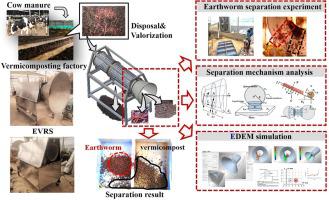Waste Management ( IF 7.1 ) Pub Date : 2021-06-05 , DOI: 10.1016/j.wasman.2021.05.031 Jiacong Lin 1 , Shuai Zhao 2 , Qiaoxia Yuan 3

|
The vermicomposting is widely acknowledged as an effective and sustainable biological technology to dispose large scale organic solid waste such as livestock manure, crop residues and municipal sludge. The scale of vermicomposting has constantly increased over recent years due to high market demand for live earthworms. Rapid and efficient extraction and harvesting earthworm from large-scale vermicompost has become a bottle-neck problem at the end of vermicomposting. Currently, most earthworm separation is done manually or relies on simple tools, and is therefore low efficient, time consuming and labor intensive. In this study, to explore earthworm separation technology and underlying mechanisms, three major studies were conducted based on the developed separator: Earthworm separation experiment, mechanism analysis of separation, and separation process simulation. The result indicated that under a 45% moisture content of vermicompost, earthworm can be separated centrifugally with approximately 83.79% worm separation rate. The treatment capacity of separator is 21.2 kg of total vermicompost mixture per minute. The critical factor in earthworm-vermicompost separation is frictional force and liquid membrane adhesion at the contact interface of conical separator. The final separated X velocity of earthworms is higher, whereas the Y and Z velocities are less than those of vermicompost. The earthworms are centrifugally thrown to a specific area called the earthworm harvest position. The outcome of this study provides a valuable reference for improvement of earthworm harvest efficiency and for shortening the recycling period of vermicomposting products in practice.
中文翻译:

蚯蚓与蚯蚓粪分离新技术:实验、机理分析与模拟
蚯蚓堆肥被广泛认为是一种有效和可持续的生物技术,可以处理大量有机固体废物,如牲畜粪便、作物残留物和城市污泥。近年来,由于市场对活蚯蚓的需求旺盛,蚯蚓堆肥的规模不断扩大。从大型蚯蚓堆肥中快速高效提取收获蚯蚓,成为蚯蚓堆肥末期的瓶颈问题。目前,蚯蚓的分离大多采用人工或简单的工具进行,效率低、耗时长、劳动强度大。本研究为探索蚯蚓分离技术及机理,在研制的分离器基础上进行了三大研究:蚯蚓分离实验、分离机理分析、和分离过程模拟。结果表明,在蚯蚓粪含水量为45%的条件下,蚯蚓可以离心分离,蚯蚓分离率约为83.79%。分离器的处理能力为每分钟 21.2 kg 的总蚯蚓粪混合物。蚯蚓-蚯蚓粪分离的关键因素是锥形分离器接触界面处的摩擦力和液膜附着力。蚯蚓的最终分离X速度较高,而Y和Z速度低于蚯蚓粪。蚯蚓被离心抛到一个特定的区域,称为蚯蚓收获位置。本研究结果为提高蚯蚓的收获效率和缩短蚯蚓堆肥产品的回收期在实践中提供了有价值的参考。结果表明,在蚯蚓粪含水量为45%的条件下,蚯蚓可以离心分离,蚯蚓分离率约为83.79%。分离器的处理能力为每分钟 21.2 kg 的总蚯蚓粪混合物。蚯蚓-蚯蚓粪分离的关键因素是锥形分离器接触界面处的摩擦力和液膜附着力。蚯蚓的最终分离X速度较高,而Y和Z速度低于蚯蚓粪。蚯蚓被离心抛到一个特定的区域,称为蚯蚓收获位置。本研究结果为提高蚯蚓的收获效率和缩短蚯蚓堆肥产品的回收期在实践中提供了有价值的参考。结果表明,在蚯蚓粪含水量为45%的条件下,蚯蚓可以离心分离,蚯蚓分离率约为83.79%。分离器的处理能力为每分钟 21.2 kg 的总蚯蚓粪混合物。蚯蚓-蚯蚓粪分离的关键因素是锥形分离器接触界面处的摩擦力和液膜附着力。蚯蚓的最终分离X速度较高,而Y和Z速度低于蚯蚓粪。蚯蚓被离心抛到一个特定的区域,称为蚯蚓收获位置。本研究结果为提高蚯蚓的收获效率和缩短蚯蚓堆肥产品的回收期在实践中提供了有价值的参考。











































 京公网安备 11010802027423号
京公网安备 11010802027423号